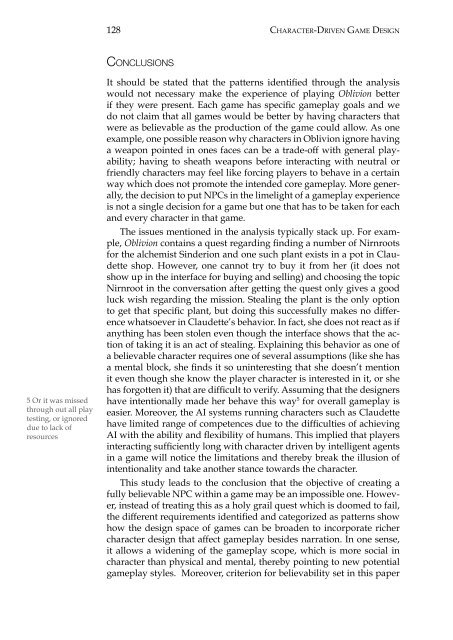Character Driven Game Design
Character Driven Game Design
Character Driven Game Design
Create successful ePaper yourself
Turn your PDF publications into a flip-book with our unique Google optimized e-Paper software.
128<br />
<strong>Character</strong>-<strong>Driven</strong> <strong>Game</strong> <strong>Design</strong><br />
Conclusions<br />
5 Or it was missed<br />
through out all play<br />
testing, or ignored<br />
due to lack of<br />
resources<br />
It should be stated that the patterns identified through the analysis<br />
would not necessary make the experience of playing Oblivion better<br />
if they were present. Each game has specific gameplay goals and we<br />
do not claim that all games would be better by having characters that<br />
were as believable as the production of the game could allow. As one<br />
example, one possible reason why characters in Oblivion ignore having<br />
a weapon pointed in ones faces can be a trade-off with general playability;<br />
having to sheath weapons before interacting with neutral or<br />
friendly characters may feel like forcing players to behave in a certain<br />
way which does not promote the intended core gameplay. More generally,<br />
the decision to put NPCs in the limelight of a gameplay experience<br />
is not a single decision for a game but one that has to be taken for each<br />
and every character in that game.<br />
The issues mentioned in the analysis typically stack up. For example,<br />
Oblivion contains a quest regarding finding a number of Nirnroots<br />
for the alchemist Sinderion and one such plant exists in a pot in Claudette<br />
shop. However, one cannot try to buy it from her (it does not<br />
show up in the interface for buying and selling) and choosing the topic<br />
Nirnroot in the conversation after getting the quest only gives a good<br />
luck wish regarding the mission. Stealing the plant is the only option<br />
to get that specific plant, but doing this successfully makes no difference<br />
whatsoever in Claudette’s behavior. In fact, she does not react as if<br />
anything has been stolen even though the interface shows that the action<br />
of taking it is an act of stealing. Explaining this behavior as one of<br />
a believable character requires one of several assumptions (like she has<br />
a mental block, she finds it so uninteresting that she doesn’t mention<br />
it even though she know the player character is interested in it, or she<br />
has forgotten it) that are difficult to verify. Assuming that the designers<br />
have intentionally made her behave this way 5 for overall gameplay is<br />
easier. Moreover, the AI systems running characters such as Claudette<br />
have limited range of competences due to the difficulties of achieving<br />
AI with the ability and flexibility of humans. This implied that players<br />
interacting sufficiently long with character driven by intelligent agents<br />
in a game will notice the limitations and thereby break the illusion of<br />
intentionality and take another stance towards the character.<br />
This study leads to the conclusion that the objective of creating a<br />
fully believable NPC within a game may be an impossible one. However,<br />
instead of treating this as a holy grail quest which is doomed to fail,<br />
the different requirements identified and categorized as patterns show<br />
how the design space of games can be broaden to incorporate richer<br />
character design that affect gameplay besides narration. In one sense,<br />
it allows a widening of the gameplay scope, which is more social in<br />
character than physical and mental, thereby pointing to new potential<br />
gameplay styles. Moreover, criterion for believability set in this paper
















